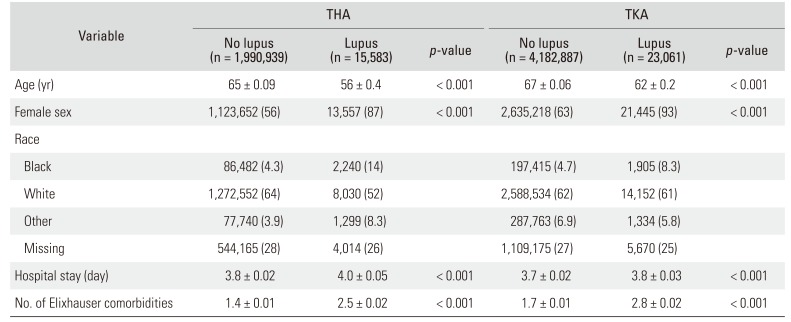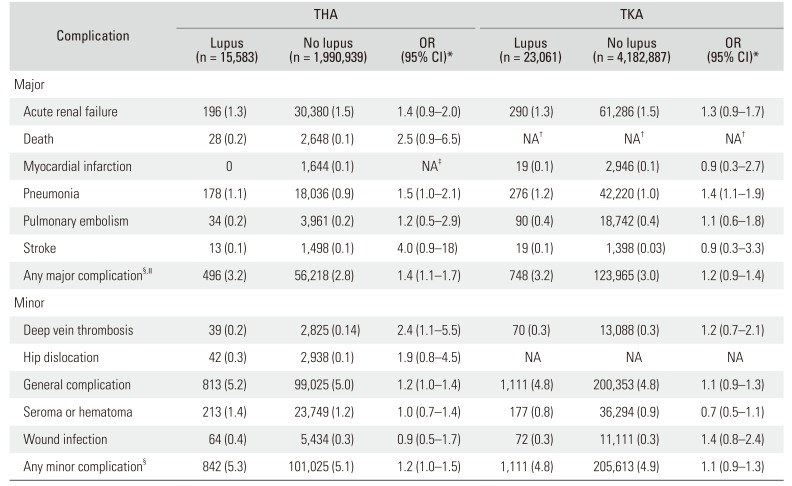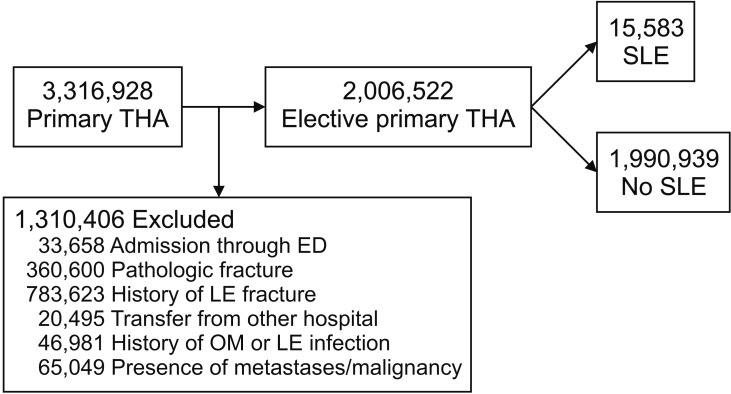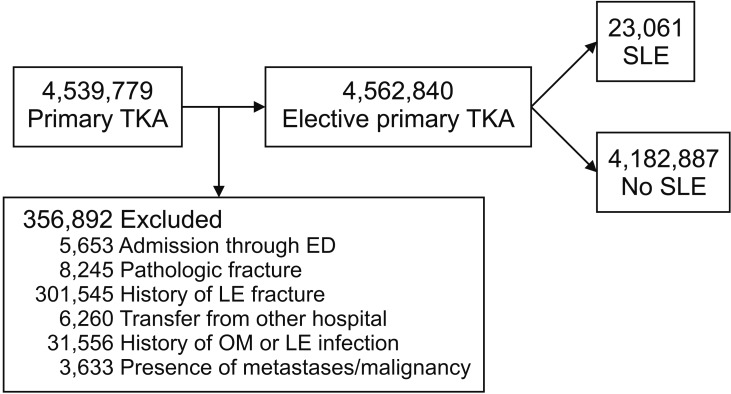1. Borchers AT, Naguwa SM, Shoenfeld Y, Gershwin ME. The geoepidemiology of systemic lupus erythematosus. Autoimmun Rev. 2010; 9(5):A277–A287. PMID:
20036343.

2. Kamen DL. Environmental influences on systemic lupus erythematosus expression. Rheum Dis Clin North Am. 2014; 40(3):401–412. PMID:
25034153.

3. Esdaile JM, Danoff D, Rosenthall L, Gutkowski A. Deforming arthritis in systemic lupus erythematosus. Ann Rheum Dis. 1981; 40(2):124–126. PMID:
7224685.

4. Issa K, Pierce TP, Scillia AJ, Festa A, Harwin SF, Mont MA. Midterm outcomes following total knee arthroplasty in lupus patients. J Arthroplasty. 2016; 31(3):655–657. PMID:
26601634.

5. Mourao AF, Amaral M, Caetano-Lopes J, Isenberg D. An analysis of joint replacement in patients with systemic lupus erythematosus. Lupus. 2009; 18(14):1298–1302. PMID:
19850657.

6. Stratta P, Marcuccio C, Campo A, et al. Improvement in relative survival of patients with vasculitis: study of 101 cases compared to the general population. Int J Immunopathol Pharmacol. 2008; 21(3):631–642. PMID:
18831931.

7. Stratta P, Mesiano P, Campo A, et al. Life expectancy of women with lupus nephritis now approaches that of the general population. Int J Immunopathol Pharmacol. 2009; 22(4):1135–1141. PMID:
20074480.

8. Mont MA, Glueck CJ, Pacheco IH, Wang P, Hungerford DS, Petri M. Risk factors for osteonecrosis in systemic lupus erythematosus. J Rheumatol. 1997; 24(4):654–662. PMID:
9101497.
9. Mok MY, Farewell VT, Isenberg DA. Risk factors for avascular necrosis of bone in patients with systemic lupus erythematosus: is there a role for antiphospholipid antibodies? Ann Rheum Dis. 2000; 59(6):462–467. PMID:
10834864.

10. Apostolopoulos D, Morand EF. It hasn't gone away: the problem of glucocorticoid use in lupus remains. Rheumatology (Oxford). 2017; 56(suppl_1):i114–i122. PMID:
28013208.

11. Di Franco M, Bazzichi L, Casale R, Sarzi-Puttini P, Atzeni F. Pain in systemic connective tissue diseases. Best Pract Res Clin Rheumatol. 2015; 29(1):53–62. PMID:
26266999.

12. Mertelsmann-Voss C, Lyman S, Pan TJ, Goodman SM, Figgie MP, Mandl LA. US trends in rates of arthroplasty for inflammatory arthritis including rheumatoid arthritis, juvenile idiopathic arthritis, and spondyloarthritis. Arthritis Rheumatol. 2014; 66(6):1432–1439. PMID:
24591462.

13. Bernatsky S, Boivin JF, Joseph L, et al. Mortality in systemic lupus erythematosus. Arthritis Rheum. 2006; 54(8):2550–2557. PMID:
16868977.

14. Trager J, Ward MM. Mortality and causes of death in systemic lupus erythematosus. Curr Opin Rheumatol. 2001; 13(5):345–351. PMID:
11604587.

15. Meacock R, Dale N, Harrison MJ. The humanistic and economic burden of systemic lupus erythematosus: a systematic review. Pharmacoeconomics. 2013; 31(1):49–61. PMID:
23329592.
16. Roberts JE, Mandl LA, Su EP, et al. Patients with systemic lupus erythematosus have increased risk of short-term adverse events after total hip arthroplasty. J Rheumatol. 2016; 43(8):1498–1502. PMID:
27307529.

17. Centers for Disease control and Prevention. ICD-9-CM: International Classification of Diseases, ninth revision, clinical modification. Washington, DC: Department of Health and Human Services;2011.
18. Quan H, Sundararajan V, Halfon P, et al. Coding algorithms for defining comorbidities in ICD-9-CM and ICD-10 administrative data. Med Care. 2005; 43(11):1130–1139. PMID:
16224307.

19. Mertelsmann-Voss C, Lyman S, Pan TJ, Goodman S, Figgie MP, Mandl LA. Arthroplasty rates are increased among US patients with systemic lupus erythematosus: 1991-2005. J Rheumatol. 2014; 41(5):867–874. PMID:
24692528.

20. Abu-Shakra M, Buskila D, Shoenfeld Y. Osteonecrosis in patients with SLE. Clin Rev Allergy Immunol. 2003; 25(1):13–24. PMID:
12794257.

21. Shah UH, Mandl LA, Mertelsmann-Voss C, et al. Systemic lupus erythematosus is not a risk factor for poor outcomes after total hip and total knee arthroplasty. Lupus. 2015; 24(9):900–908. PMID:
25595621.

22. Ponnusamy KE, Kim TJ, Khanuja HS. Perioperative blood transfusions in orthopaedic surgery. J Bone Joint Surg Am. 2014; 96(21):1836–1844. PMID:
25378512.

23. Chen Y, Chen Z, Cui S, Li Z, Yuan Z. Topical versus systemic tranexamic acid after total knee and hip arthroplasty: a meta-analysis of randomized controlled trials. Medicine (Baltimore). 2016; 95(41):e4656. PMID:
27741100.
24. Al Kazzi ES, Lau B, Li T, Schneider EB, Makary MA, Hutfless S. Differences in the prevalence of obesity, smoking and alcohol in the United States Nationwide Inpatient Sample and the Behavioral Risk Factor Surveillance System. PLoS One. 2015; 10(11):e0140165. PMID:
26536469.

25. Bozic KJ, Bashyal RK, Anthony SG, Chiu V, Shulman B, Rubash HE. Is administratively coded comorbidity and complication data in total joint arthroplasty valid? Clin Orthop Relat Res. 2013; 471(1):201–205. PMID:
22528384.







 PDF
PDF ePub
ePub Citation
Citation Print
Print




 XML Download
XML Download